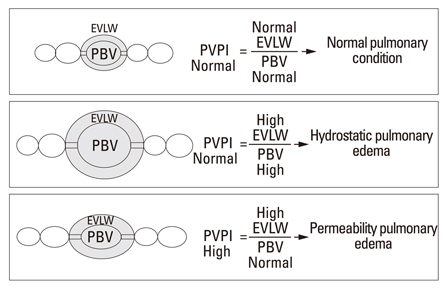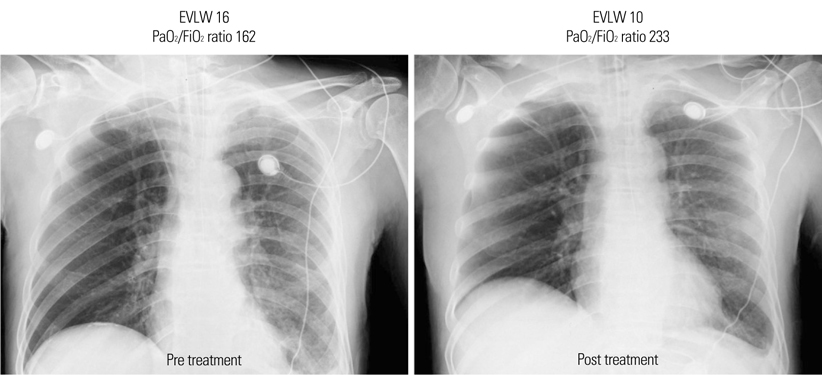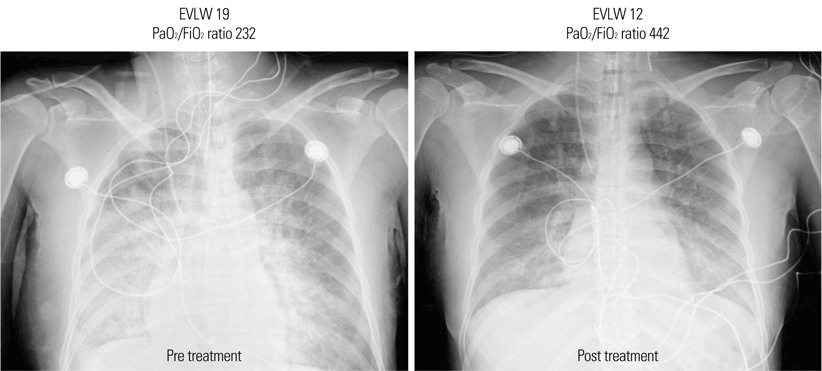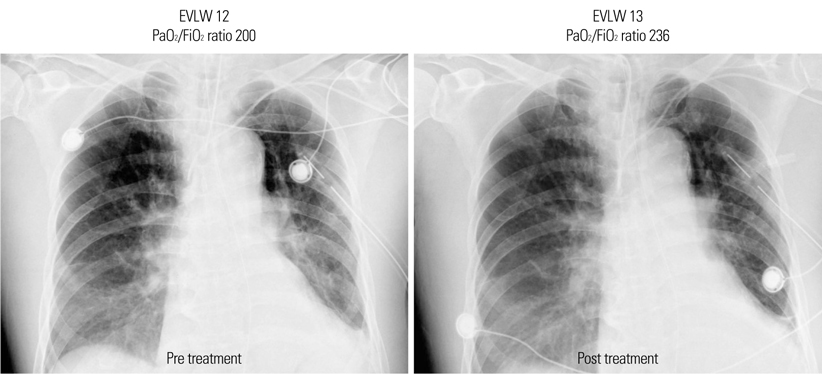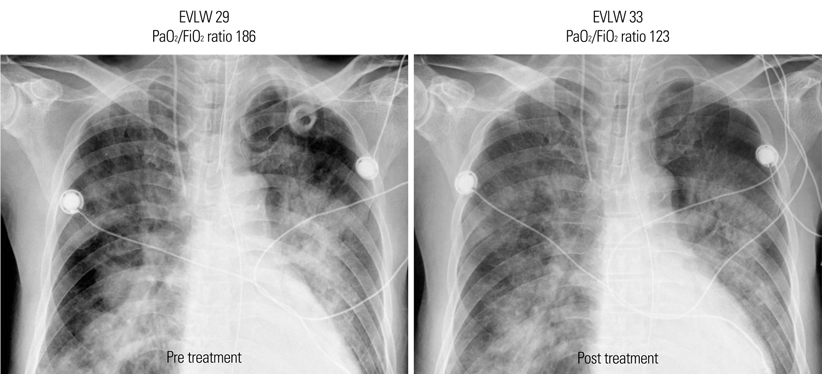Yonsei Med J.
2010 May;51(3):354-359. 10.3349/ymj.2010.51.3.354.
Effectiveness of Human Atrial Natriuretic Peptide Supplementation in Pulmonary Edema Patients Using the Pulse Contour Cardiac Output System
- Affiliations
-
- 1Department of Emergency and Critical Care Medicine, Chiba-Hokusoh Hospital, Nippon Medical School, Chiba, Japan. y-sakamoto@nms.ac.jp
- 2Department of Emergency and Critical Care Medicine, Nippon Medical School, Tokyo, Japan.
- KMID: 1074986
- DOI: http://doi.org/10.3349/ymj.2010.51.3.354
Abstract
- PURPOSE
Atrial natriuretic peptide (ANP) has a variety of pharmacologic effects, including natriuresis, diuresis, vasodilatation, and suppression of the renin-angiotensin system. A recent study showed that ANP infusion improved hypoxemia and pulmonary hypertension in a lung injury model. On the other hand, the pulse contour cardiac output (PiCCO(TM)) system (Pulsion Medical Systems, Munich, Germany) allows monitoring of the intravascular volume status and may be used to guide volume therapy in severe sepsis and critically ill patients.
MATERIALS AND METHODS
We treated 10 pulmonary edema patients without heart disease with human ANP (HANP). The patients were divided into two groups: a group with normal Intrathoracic Blood Volume (ITBV) (900-1100 mL/m2) (n = 6), and a group with abnormal ITBV (n = 4), as measured by the PiCCOtrade mark device; the extravascular lung water (EVLW) and pulmonary vascular permeability index (PVPI) in the two groups were compared.
RESULTS
The average patient age was 63.9 +/- 14.4 years. The normal ITBV group showed significant improvement of the EVLW (before, 16.7 +/- 2.7 mL/kg; after, 10.5 +/- 3.6 mL/kg; p = 0.0020) and PVPI (before, 3.2 +/- 0.3; after, 2.1 +/- 0.7; p = 0.0214) after the treatment. The abnormal ITBV group showed no significant improvement of either the EVLW (before, 16.3 +/- 8.9 mL/kg; after, 18.8 +/- 9.6 mL/kg; p = 0.8387) or PVPI (before, 2.3 +/- 0.8; after, 2.7 +/- 1.3; p = 0.2782) after the treatment. In both groups, the EVLW and PVPI were strongly correlated with the chest X-ray findings.
CONCLUSION
We conclude that HANP supplementation may improve the EVLW and PVPI in pulmonary edema patients without heart disease with a normal ITBV. The PiCCO(TM) system seems to be a useful device for the management of pulmonary edema.
Keyword
MeSH Terms
Figure
Reference
-
1. Needleman P, Greenwald JE. Atriopeptin: a cardiac hormone intimately involved in fluid, electrolyte, and blood-pressure homeostasis. N Engl J Med. 1986. 314:828–834.
Article2. Tanabe M, Ueda M, Endo M, Kitajima M. Effect of acute lung injury and coexisting disorders on plasma concentrations of atrial natriuretic peptide. Crit Care Med. 1994. 22:1762–1768.
Article3. Langman CB, Engle WD, Baumgart S, Fox WW, Polin RA. The diuretic phase of respiratory distress syndrome and its relationship to oxygenation. J Pediatr. 1981. 98:462–466.
Article4. Heaf DP, Belik J, Spitzer AR, Gewitz MH, Fox WW. Changes in pulmonary function during the diuretic phase of respiratory distress syndrome. J Pediatr. 1982. 101:103–107.
Article5. Tanabe M, Ueda M, Endo M, Kitajima M. The effect of atrial natriuretic peptide on pulmonary acid injury in a pig model. Am J Respir Crit Care Med. 1996. 154:1351–1356.6. Mitaka C, Hirata Y, Nagura T, Tsunoda Y, Amaha K. Beneficial effect of atrial natriuretic peptide on pulmonary gas exchange in patients with acute lung injury. Chest. 1998. 114:223–228.7. Sumi K, Iida H, Yamaguchi S, Fukuoka N, Shimabukuro K, Dohi S. Human atrial natriuretic peptide prevents the increase in pulmonary artery pressure associated with aortic unclamping during abdominal aortic aneurysmectomy. J Cardiothorac Vasc Anesth. 2008. 22:204–209.
Article8. Berkowitz DM, Danai PA, Eaton S, Moss M, Martin GS. Accurate characterization of extravascular lung water in acute respiratory distress syndrome. Crit Care Med. 2008. 36:1803–1809.
Article9. Imamura T, Ohnuma N, Iwasa F, Furuya M, Hayashi Y, Inomata N, et al. Prorective effect of aipha-human atrial natriuretic polypeptide (alpha-hANP) on chemical induced pulmonary edema. Life Sci. 1988. 42:403–414.
Article10. Baron DA, Lofton CE, Newman WH, Currie MG. Atriopeptin inhibition of thrombin-mediated changes in the morphology and permeability of endothelial monolayers. Proc Natl Acad Sci U S A. 1989. 86:3394–3398.
Article11. Lofton CE, Baron DA, Heffner JE, Currie MG, Newman WH. Atrial natriuretic peptide inhibits oxidant-induced increases in endothelial permeability. J Mol Cell Cardiol. 1991. 23:919–927.
Article12. Michard F. Bedside assessment of extravascular lung water by dilution methods: temptations and pitfalls. Crit Care Med. 2007. 35:1186–1192.
Article
- Full Text Links
- Actions
-
Cited
- CITED
-
- Close
- Share
- Similar articles
-
- Plasma Atrial Natriuertic Peptide (ANP) Levels and Hemodynamic Data in Patient with Heart Disease
- Expression of natriuretic peptide mRNAs in isoproterenol-induced cardiac hypertrophy in rats.
- The Role of Pulmonary Circulation in the Metabolism of Atrial Natriuretic Factor in Man
- Effect of Cardiac Rhythm on Hemodynamic Changes and Pulmonary Arterial Atrial Natriuretic Peptide Levels after Percutaneous Mitral Valvuloplasty
- Change of Plasma Atrial Natriuretic Peptide(ANP) before and after Percutaneous Ballon Mitral Valvuloplasty(PMV)

